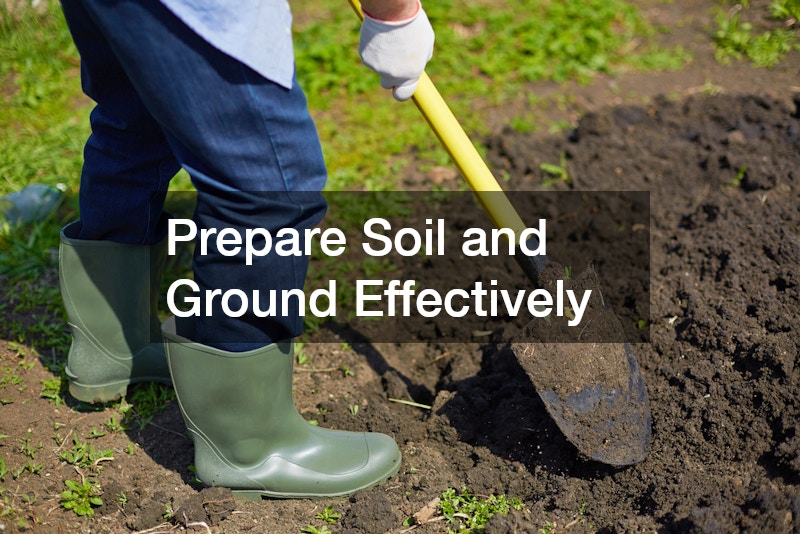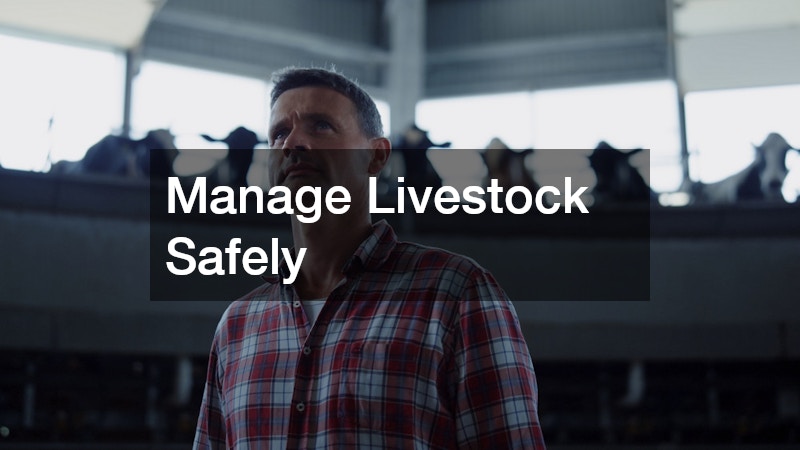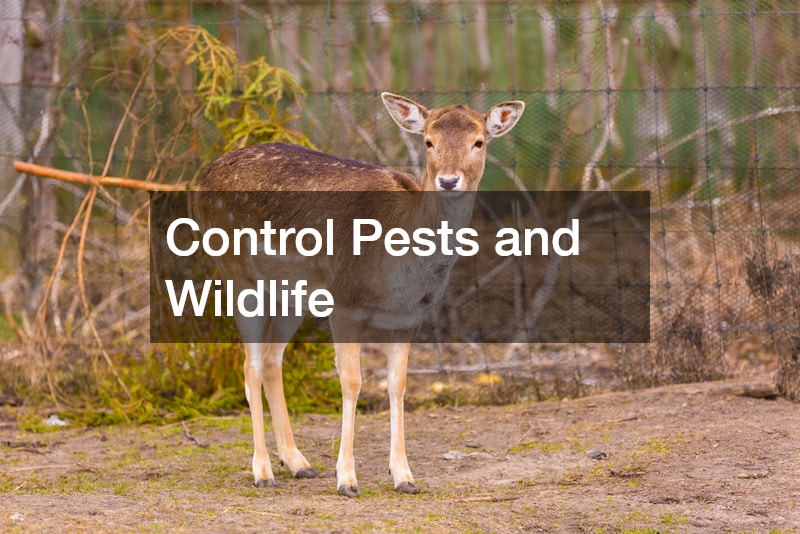Starting a homestead can be one of the most rewarding yet demanding endeavors for anyone seeking a self-sufficient lifestyle. Balancing the demands of planting crops, raising animals, managing equipment, and maintaining land requires careful planning and constant attention. Effective farm management is essential to avoid costly mistakes and ensure that each component of the homestead works in harmony. For new homesteaders, understanding how to integrate technology, organize tasks, and leverage resources efficiently lays the groundwork for long-term success. This approach not only improves productivity but also supports sustainable practices that protect soil, water, and wildlife over time.
1. Prepare Soil and Ground Effectively

Healthy soil is the foundation of every successful homestead. Preparing soil properly involves testing for nutrient levels, amending deficiencies, and ensuring good drainage to support crops and pastures. Implementing crop rotation, cover cropping, and organic amendments can strengthen the soil while reducing the risk of erosion and nutrient depletion. Farm management begins with recognizing the critical role of soil quality and investing time in preparing the land correctly before planting or building structures. Understanding how to work with soil conditions in different seasons is also crucial, as wet or compacted soil can delay planting and reduce overall productivity.
Dirt delivery is often an essential service for new homesteaders who need to reshape or improve their land. Whether it’s filling low-lying areas, leveling a new garden plot, or creating raised beds, quality dirt ensures a fertile base for crops and reduces water pooling in problem areas. Incorporating dirt delivery into a management plan allows for consistent soil quality across different fields and supports efficient irrigation and drainage systems. Planning ahead for these adjustments not only improves crop yields but also simplifies long-term maintenance.
Adding mulch and organic compost to prepared soil can further enhance fertility and water retention. These additions improve the soil’s structure, reduce evaporation, and provide a natural buffer against pests and weeds. By combining these strategies with dirt delivery, homesteaders can create a highly productive foundation that supports both short-term planting goals and long-term soil health.
2. Maintain Water Systems Regularly
Reliable water systems are critical to the success of any homestead. Effective farm management requires understanding water flow, preventing blockages, and ensuring that irrigation and livestock watering systems operate smoothly. Monitoring water pressure, cleaning filters, and planning for seasonal fluctuations are all essential tasks. Proper maintenance reduces downtime, conserves resources, and helps sustain healthy crops and animals.
Hydro jetting is a highly effective method for keeping pipes and drainage systems clear of sediment, algae, and other blockages. This technique is particularly useful for maintaining irrigation lines or water storage tanks that are prone to buildup over time. By incorporating hydro jetting into routine management practices, new homesteaders can ensure consistent water delivery, prevent costly repairs, and reduce the risk of waterborne issues that could affect livestock or crops. A well-maintained water system supports not only daily operations but also the long-term sustainability of the homestead.
Additionally, installing water monitoring systems can provide real-time insights into flow rates and pressure changes, helping to identify problems before they escalate. Sensors, timers, and automated alerts allow homesteaders to manage water use efficiently and conserve this vital resource. Integrating technology with hydro jetting and routine maintenance strengthens overall farm management by reducing waste, preventing damage, and ensuring that crops and animals always have reliable access to water.
3. Manage Livestock Safely

Raising animals requires a combination of knowledge, infrastructure, and attentive care. Proper livestock management is a core aspect of farm management, as it ensures animal welfare, reduces the risk of injury, and promotes productive herds. Understanding animal behavior, feeding cycles, and health requirements allows homesteaders to develop routines that support both the animals and the farm’s overall efficiency. Secure enclosures, rotational grazing, and preventive veterinary care all contribute to safe and successful livestock operations.
Using a hog trap can be a practical solution for controlling certain types of livestock or deterring wild hogs that threaten crops and pens. A well-placed trap allows animals to be safely captured or relocated without causing injury. Combining traps with proper fencing, feeding schedules, and regular health checks ensures that livestock remains healthy and manageable throughout the year.
Regular record-keeping for each animal, including vaccination schedules, breeding cycles, and feeding logs, paves the way to success by allowing homesteaders to track performance and detect health issues early. Detailed records help optimize feeding strategies, improve reproductive outcomes, and support long-term planning for herd expansion.
4. Maintain Equipment Consistently
Farm equipment is central to nearly every aspect of homesteading, from plowing and planting to harvesting and transporting materials. Effective management requires scheduled inspections, lubrication, and timely repairs to prevent downtime. Understanding the basic mechanics of tractors, implements, and other machinery empowers homesteaders to troubleshoot minor issues before they become major problems, extending the life of valuable tools.
Accessing local tractor repair services ensures that machinery receives professional attention when issues arise. Skilled technicians can quickly identify problems, replace parts, and restore functionality, keeping operations on schedule. Integrating repair services into a management plan reduces the stress of unexpected breakdowns and allows homesteaders to focus on other critical tasks. Regular maintenance paired with professional repairs contributes to efficiency, safety, and long-term operational success.
Developing a preventive maintenance schedule, including oil changes, tire inspections, and hydraulic checks, further strengthens management practices. By anticipating repairs and replacing worn parts before they fail, homesteaders reduce costly downtime and ensure machinery is ready for seasonal workloads. Combining local repair support with a proactive maintenance approach optimizes equipment performance and supports consistent farm productivity.
5. Control Pests and Wildlife

Managing pests and wildlife is a vital component of management, as uncontrolled animals can damage crops, spread disease, and disrupt homestead operations. Implementing preventive measures, monitoring activity, and taking action when problems arise help protect both plants and livestock. Understanding local wildlife patterns also allows homesteaders to coexist with animals in ways that minimize damage while maintaining ecological balance.
Wildlife removal services can assist in safely relocating animals that pose a threat to crops or livestock. Professionals handle raccoons, deer, and other problem species in a way that prevents harm while keeping the property secure. Incorporating wildlife removal into operations ensures that homesteaders maintain healthy gardens and pastures, protecting investments and reducing the risk of injury or contamination. Coordinated strategies for animal control complement other management practices to create a safe and productive environment.
6. Organize Waste Disposal Efficiently
Efficient waste management is a crucial part of farm management. Accumulated debris, organic waste, and old equipment can create hazards, attract pests, and clutter operational areas. Planning for regular disposal, composting, and recycling helps maintain an organized, safe, and sustainable homestead. By integrating waste management into daily routines, new homesteaders can improve productivity and reduce environmental impacts.
Dumpster rental services simplify large-scale waste disposal, whether during construction projects, seasonal cleanups, or routine maintenance. Selecting the right size and scheduling regular pickups keeps the property clean and organized while allowing homesteaders to focus on essential tasks. Incorporating dumpster rental into a management plan ensures debris is handled efficiently and safely, reducing hazards and maintaining an orderly workspace for long-term operations.
7. Prepare Land for Construction

Building structures such as barns, greenhouses, or fencing requires careful land preparation. Proper grading, leveling, and site preparation are key elements of effective farm management. Well-prepared land ensures that buildings are stable, water drains correctly, and construction projects proceed without unnecessary delays. Planning site work in advance allows homesteaders to avoid costly mistakes and maintain productive areas for both animals and crops.
Excavation services provide professional equipment and expertise to prepare land efficiently. From digging foundations to leveling uneven terrain, these services reduce labor demands and improve precision. Integrating excavation into a management strategy ensures that construction projects are completed safely and effectively. By investing in professional support, new homesteaders can save time, prevent setbacks, and establish infrastructure that supports long-term growth.
Adding proper drainage and erosion control during land preparation further strengthens management outcomes. Techniques such as retaining walls, swales, or gravel paths protect buildings and fields from water damage and soil loss. When combined with excavation services, these measures ensure the property remains functional, safe, and productive for decades.
8. Coordinate Projects Across the Farm
Effective farm management requires coordination across multiple projects and areas. Homesteaders must balance planting schedules, animal care, equipment maintenance, and construction projects simultaneously. Clear planning, task prioritization, and resource allocation prevent bottlenecks and ensure smooth operations. Developing a structured approach reduces stress and improves overall productivity.
Working with a site work company can help homesteaders manage complex tasks such as grading, drainage, and trenching. Outsourcing specialized labor frees time for daily farm responsibilities while ensuring that projects are completed correctly. Incorporating professional support into a management plan promotes efficiency, reduces the risk of errors, and allows for smoother progress across multiple areas of the property. This coordination is critical to maintaining a well-functioning and organized homestead.
Tracking project timelines and setting milestones also enhances management. Using project management tools or simple spreadsheets helps homesteaders visualize progress, allocate resources, and anticipate potential conflicts. Combined with professional site work assistance, this structured approach ensures that tasks are completed on schedule and that the farm operates efficiently throughout the year.
9. Implement Technology for Precision Farming
Integrating technology into homestead operations enhances efficiency and accuracy. Farm management today involves using GPS-guided equipment, automated irrigation, and monitoring systems to optimize productivity. These tools reduce labor requirements, prevent waste, and provide data that supports informed decision-making. Understanding how to leverage technology allows homesteaders to maximize yields while minimizing resource use.
Agriculture autosteering systems are particularly useful for ensuring precise tractor movements during planting, harvesting, and field maintenance. This technology minimizes overlap, reduces soil compaction, and improves overall efficiency. Incorporating autosteering into a management plan ensures consistent results across large fields and supports sustainable practices. Technology integration empowers new homesteaders to operate with greater confidence, accuracy, and productivity.
Remote monitoring sensors and management apps can further enhance precision. By tracking soil moisture, temperature, and crop growth in real time, homesteaders can make immediate adjustments to irrigation, fertilization, and harvesting schedules. Combined with autosteering, these tools provide a comprehensive approach to modern farming, improving both efficiency and long-term sustainability.
10. Install and Maintain Waste Systems
Sanitation and waste management are essential for long-term farm success. Properly installed septic systems, drainage, and composting areas help maintain hygiene, prevent contamination, and support environmental sustainability. Farm management strategies that include regular monitoring and maintenance of waste systems reduce risks to both people and livestock, ensuring a safe and productive homestead.
Septic tank installation is a critical element of effective waste management for properties without access to municipal sewage. Proper installation and regular inspections prevent leaks, backups, and environmental hazards. Incorporating septic systems into a farm management plan ensures safe sanitation infrastructure, complements other operational areas, and supports long-term sustainability. Combining professional installation with ongoing maintenance protects both homesteaders and the surrounding ecosystem.
Regularly testing soil absorption and monitoring tank capacity strengthens management by preventing overflow or system failures. Implementing clear maintenance schedules and keeping detailed records allows homesteaders to address issues early, avoid costly repairs, and maintain safe living conditions. By integrating these practices with septic tank installation, the homestead remains hygienic, productive, and resilient over time.
Managing a homestead requires dedication, foresight, and the integration of multiple strategies to ensure long-term success. Effective management encompasses soil preparation, water system maintenance, livestock care, equipment upkeep, pest control, and waste management. Utilizing professional services such as dirt delivery, hydro jetting, or septic tank installation enhances efficiency and reliability, allowing homesteaders to focus on the daily care of crops and animals.
Coordinating projects, leveraging technology, and maintaining infrastructure are all critical components of a comprehensive farm management approach. By investing time and effort into structured planning and consistent maintenance, homesteaders can create a thriving property that provides both personal satisfaction and long-term productivity. Ultimately, success on a homestead comes from combining practical knowledge, professional support, and diligent care, ensuring a prosperous and resilient farm for years to come.


